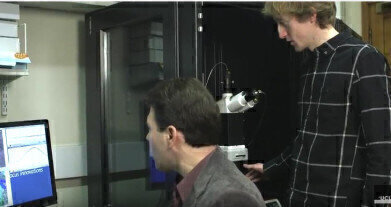-
 Dominic Papineau and Matt Dodd in the Geological Spectroscopy Laboratory. Copyright: UCL (UK)
Dominic Papineau and Matt Dodd in the Geological Spectroscopy Laboratory. Copyright: UCL (UK)
News & Views
Microfossil Data Narrows Window for the Origin of Life
May 15 2017
Bubbling submarine-hydrothermal vents are believed to be the places where life on Earth emerged. Whether that happened 3.5 or 3.7 billion years ago or even further into the past is subject of intense discussion in the scientific community. Why? Because it is hard to determine whether or not chemical traces in very old sedimentary rocks– such as isotopically light graphitic carbon are metamorphosed products of biological organic material. Dr Dominic Papineau, a geologist who has long followed the tracks of early life and PhD student Matthew Dodd, both from University College London (UK), along with colleagues used a microscopic approach to look for the answer. With optical microscopy they imaged thin sections from rocks found in the Nuvvuagittuq Supracrustal Belt (NSB) in Canada that once belonged to a very early oceanic crust. They identified a suite of chemical and morphology features indicative of microbial activity.
Through chemical imaging performed with a WITec alpha300R confocal Raman microscope, the scientists could identify the compounds – graphitic carbon, calcite, haematite, quartz, magnetite and apatite - therein and their spatial distribution. Modern iron-oxidizing bacteria living in hot vents can form Fe-containing filaments and tubes. For that reason along with isotopically depleted carbon and biominerals apatite and carbonate, scientists believe that similar structures in much older rocks indicate a biogenic origin. Similar structures found in the Løkken jasper in Norway that geologically is somewhat younger than the NSB had already been attributed to mineralised bacteria. So the authors of the current study suggested that the mineral assemblages they had seen are also of biogenic origin. They concluded: “Preservation in the NSB of carbonaceous material and minerals in diagenetic rosettes and granules that formed from the oxidation of biomass, together with the presence of tubes similar in mineralogy and morphology to those in younger jaspers interpreted as microfossils, reveal that life established a habitat near submarine-hydrothermal vents before 3,770 million years ago and possibly as early as 4,290 million years ago.”
Dominic Papineau wrote: “We used the WITec micro-Raman to map, down to sub-micron scales, the minerals associated with the oldest microfossils on Earth. This was vital to the discovery of key structures like rosettes, granules as well as minerals associated with the filamentous microfossils such as micron-size apatite, carbonate and graphitic carbon, all of which point to the metamorphosed mineralised product of decayed microbial organic matter.”
Digital Edition
Lab Asia 31.2 April 2024
April 2024
In This Edition Chromatography Articles - Approaches to troubleshooting an SPE method for the analysis of oligonucleotides (pt i) - High-precision liquid flow processes demand full fluidic c...
View all digital editions
Events
Apr 25 2024 Istanbul, Turkey
Apr 28 2024 Montreal, Quebec, Canada
May 05 2024 Seville, Spain
InformEx Zone at CPhl North America
May 07 2024 Pennsylvania, PA, USA
May 14 2024 Oklahoma City, OK, USA

















